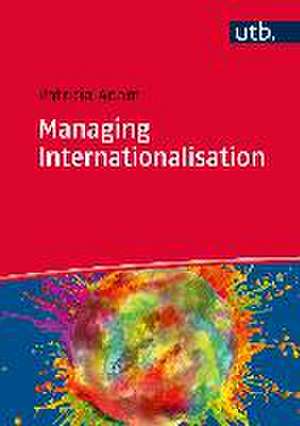Managing Internationalisation
Autor Patricia Adamen Limba Engleză Hardback – 17 iun 2015
Preț: 303.40 lei
Nou
Puncte Express: 455
Preț estimativ în valută:
58.07€ • 63.10$ • 48.81£
58.07€ • 63.10$ • 48.81£
Carte indisponibilă temporar
Doresc să fiu notificat când acest titlu va fi disponibil:
Se trimite...
Preluare comenzi: 021 569.72.76
Specificații
ISBN-13: 9783825286163
ISBN-10: 3825286169
Pagini: 366
Dimensiuni: 174 x 246 x 30 mm
Greutate: 0.82 kg
Editura: UTB GmbH
ISBN-10: 3825286169
Pagini: 366
Dimensiuni: 174 x 246 x 30 mm
Greutate: 0.82 kg
Editura: UTB GmbH
Notă biografică
Prof. Dr. Patricia A. Adam lehrt seit 2004 an der Hochschule Hannover Betriebswirtschaftslehre, insbesondere International Management.
Cuprins
Preface 5Acknowledgements 6Table of Figures 131 Introduction and Overview Strategic International Management 191.1 Introduction 201.1.1 How to Use This Book 201.1.2 From Gradual Globalisation to Transnational Organisations 21VIPs 261.2 The Use of Holistic Management Models 27VIPs 291.3 The Approach of the EFQM Excellence Model 301.3.1 Background Information: The EFQM and its Model 301.3.2 The Fundamental Concepts of Excellence 301.3.3 The EFQM Excellence Model Framework 2013 331.3.4 The EFQM RADAR Logic 36VIPs 381.4 Process Model "Managing Internationalisation" 381.5 Citations & Notes 392 Key Issue: Developing Cross-Cultural Competence 412.1 The Importance of Intercultural Understanding for International Business Issues 422.2 Hofstede's Framework: Cultures and Organisations 442.2.1 Culture as a Part of Human Mental Programming 44VIPs 452.2.2 An Introduction to Hofstede's Dimensions 462.2.3 Power Distance 472.2.4 Individualism/Collectivism 502.2.5 Masculinity/Femininity 512.2.6 Uncertainty Avoidance 532.2.7 Long-Term Orientation 542.2.8 Establishing Country Clusters 562.2.9 Adding a New Dimension: Indulgence versus Restraint 58VIPs 592.3 The Dilemma Approach of Trompenaars & Hampden-Turner 602.3.1 A View of Culture Based on Dilemmas 60VIPs 612.3.2 Universalism versus Particularism 612.3.3 Individualism versus Communitarianism 632.3.4 Neutrality versus Affection 632.3.5 Specificity versus Diffusion 642.3.6 Achieved versus Ascribed Status 652.3.7 The Concept of Time 662.3.8 Inner versus Outer Direction 682.3.9 Reconciling Dilemmas 69VIPs 712.4 Globe Study: More Issues Arising 71VIPs 732.5 Critical Acclaim 732.5.1 Typical Problems of Cross-Cultural Research 732.5.2 Critical Acclaim of Hofstede's Dimensions 742.5.3 Critical Acclaim of Trompenaars & Hampden-Turner's Dilemmas 752.5.4 Critical Acclaim of the GLOBE Study 762.6 Citations & Notes 773 Leading the Internationalisation Process 813.1 Good Leadership 823.1.1 The Coherent Leadership Approach 82VIPs 883.1.2 Excellent Leaders: EFQM Criterion 1 883.2 Developing the Mission, Vision, Values and Ethics 893.2.1 Defining and Communicating the Core Purpose of an Organisation 89VIPs 923.2.2 Acting as Role Models for Ethical Behaviour 923.2.2.1 Corporate Ethics and Social Responsibility 923.2.2.2 Ethical Behaviour in International Business 93VIPs 963.2.3 Communicating Direction and Uniting the Organisation's People 963.2.5 Developing and Reviewing Leadership Culture 973.2.5.1 Developing and Supporting a Shared Leadership Culture 973.2.5.2 Reviewing and Improving Leadership Behaviour 99VIPs 1013.3 Driving Performance and Engaging with External Stakeholders 1013.4 Reinforcing a Culture of Excellence 1023.4.1 Developing an Excellent Organisational Culture 1023.4.2 Promoting and Encouraging Diversity 104VIPs 1073.5 Managing Change 107VIPs 1113.6 Citations & Notes 1114 Defining and Delivering an International Strategy 1154.1 Strategy and the Strategy Management Process 1164.1.1 Popular Strategy Definitions 1164.1.2 Comprehensive Strategy Management Processes: EFQM Criterion 2 1164.2 Scanning the Environment 1184.2.1 Understanding the Needs and Expectations of Stakeholders 1184.2.2 Analysing Industry and Markets 1194.2.3 Identifying and Understanding Environmental Key Trends 1224.2.4 Predicting Future Developments and Changes 126VIPs 1284.3 Analysing Internal Performance 1294.3.1 Understanding Operational Performance and Capabilities 1294.3.2 Determining Competencies of Partners and Potential Impacts of Changes 1324.3.3 Bringing It All Together: Portfolios 132VIPs 1354.4 Developing the Strategy 1364.4.1 Strategy Levels 1364.4.2 Generating a Sustainable Business Model 1374.4.3 Business Model Choices 1404.4.4 Establishing a Strategy Development Process 143VIPs 1454.5 Communicating and Implementing the Strategy 1464.6 Citations & Notes 1475 Deploying Strategy through People 1515.1 International Human Resource Management 1525.1.1 The International HRM Function 1525.1.2 Managing People: EFQM Criterion 3 1545.2 Supporting the Strategy through People Plans 1545.2.1 Steering Human Resource Management Strategically 154VIPs 1565.2.2 Planning Global Mobility 156VIPs 1625.2.3 Closing the Loop: People Feedback 162VIPs 1675.3 Developing People and Their Performance 1675.3.1 Developing People's Skills and Competencies 167VIPs 1705.3.2 Helping People to Improve Their Performance 170VIPs 1775.3.3 Appraising Performance Systematically 1775.3.4 Empowering and Involving People 181VIPs 1845.4 Communicating Effectively 185VIPs 1895.5 Recognising People 189VIPs 193Citations & Notes 1946 Managing International Partners and Resources 1976.1 A Broad View on Resources: EFQM Criterion 4 1986.2 Establishing International Partnerships for Mutual Benefit 1996.2.1 Selecting an Appropriate Foreign Operation Mode 1996.2.1.1 Cross-Border Strategic Alliances 200VIPs 2026.2.1.2 Contractual Agreements in International Operations 2026.2.1.3 International Joint Ventures 2046.2.1.4 Mergers & Acquisitions across Borders and Cultures 2066.2.2 Managing International Partners 210VIPs 2126.3 Managing Finance and Governance Processes 2136.3.1 Optimising Organisational Financial Management 213VIPs 2186.3.2 Ensuring Compliance 219VIPs 2256.3.3 Managing Risks 225VIPs 2306.4 Managing Knowledge and Information 2306.4.1 Managing Knowledge Systematically 230VIPs 2366.4.2 Establishing Integrated (Management) Information Systems 2376.5 Citations & Notes 2397 Managing Processes and Products Globally 2437.1 Delivering Stakeholder Value: EFQM Criterion 5 2447.2 Managing Processes 244VIPs 2507.3 Managing Products and Services Based on ISO 9001 2517.3.1 Introducing a Certifiable Quality Management System 251VIPs 2547.3.2 Managing Products and Services Globally 254VIPs 26112 Table of Contents7.3.3 Enhancing Customer Relationships 2617.4 Citations & Notes 2648 Achieving and Monitoring Balanced Results 2678.1 EFQM Results Criteria 2688.2 Introducing the Balanced Scorecard Concept 272VIPs 2758.3 Monitoring Achievements by Designing Meaningful Dashboards 275VIPs 2798.4 Citations & Notes 2799 Assessing the Organisation's Management Model 2819.1 Establishing Strategy Reviews for Continuous Improvement 282VIPs 2849.2 Implementing Self-Assessments 2849.2.1 Introducing Self-Assessment Tools 284VIPs 2889.2.2 Conducting a Simulated Award Assessment 289VIPs 2949.3 Achieving External Recognition and Winning Excellence Awards 295VIPs 2989.4 Citations & Notes 298References 301List of Abbreviations 323Glossary 329Index 359
